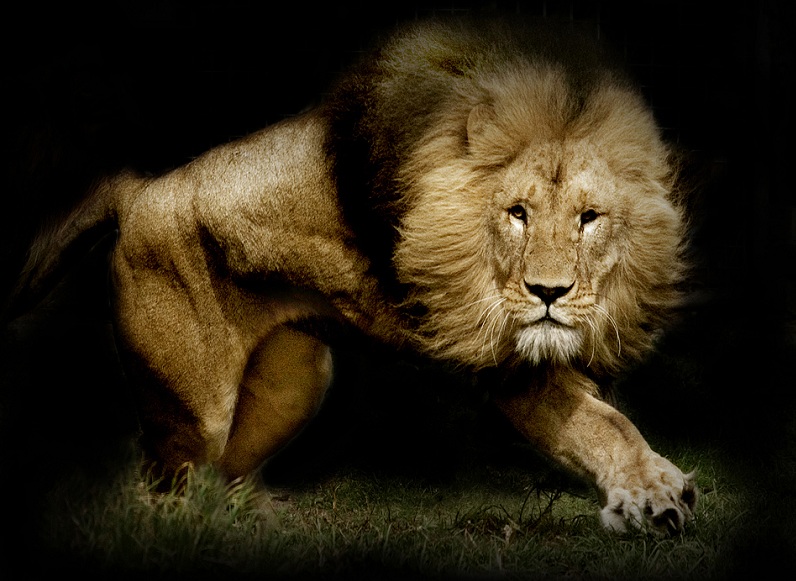Lions!!!!
Lions are the only cats that live in groups, which are called prides. Prides are family units that may include up to three males, a dozen or so females, and their young. All of a pride's lionesses are related, and female cubs typically stay with the group as they age. Young males eventually leave and establish their own prides by taking over a group headed by another male.
Only male lions boast manes, the impressive fringe of long hair that encircles their heads. Males defend the pride's territory, which may include some 100 square miles (259 square kilometers) of grasslands, scrub, or open woodlands. These intimidating animals mark the area with urine, roar menacingly to warn intruders, and chase off animals that encroach on their turf.
Female lions are the pride's primary hunters. They often work together to prey upon antelopes, zebras, wildebeest, and other large animals of the open grasslands. Many of these animals are faster than lions, so teamwork pays off.
After the hunt, the group effort often degenerates to squabbling over the sharing of the kill, with cubs at the bottom of the pecking order. Young lions do not help to hunt until they are about a year old. Lions will hunt alone if the opportunity presents itself, and they also steal kills from hyenas or wild dogs.
Lions have been celebrated throughout history for their courage and strength. They once roamed most of Africa and parts of Asia and Europe. Today they are found  only in parts of sub-Saharan Africa, except for one very small population of Asian lions that survives in India's Gir Forest.
only in parts of sub-Saharan Africa, except for one very small population of Asian lions that survives in India's Gir Forest.
Fast Facts
- Type:
- Mammal
- Diet:
- Carnivore
- Size:
- Head and body, 4.5 to 6.5 ft (1.4 to 2 m); Tail, 26.25 to 39.5 in (67 to 100 cm)
- Weight:
- 265 to 420 lbs (120 to 191 kg)
- Group name:
- Pride
- Protection status:
- Vulnerable
- Size relative to a 6-ft (2-m) man:
-

 Renowned for its majesty and nicknamed "the king of the jungle," the lion possesses both beauty and strength. Lions vary in color but typically sport light yellow-brown coats. Mature male lions are unique among big cats due the thick brown or black manes that encircle their necks and protect them while fighting.
Renowned for its majesty and nicknamed "the king of the jungle," the lion possesses both beauty and strength. Lions vary in color but typically sport light yellow-brown coats. Mature male lions are unique among big cats due the thick brown or black manes that encircle their necks and protect them while fighting.
Diet
Lions consume a wide variety of prey, from wildebeest, impala, zebra, giraffe, buffalo and wild hogs to sometimes rhinos and hippos. They will also feed on smaller animals such as hares, birds and reptiles. Lions are also known to attack elephants when food is scarce.
Population
The lion population in Africa has been reduced by half since the early 1950s. Today, fewer than 21,000 remain in all of Africa.
Range
Though lions used to live in most parts of Africa, they are now found only in the south Sahara desert and in parts of southern and eastern Africa. Historically, in addition to Africa, lions were found from Greece through the Middle East to northern India.
Behavior
Did You Know?
Both male and female lions roar, and that roar can be heard over five miles away!
The only social member of the cat (Felidae) family, lions live in large groups called "prides," consisting of about 15 lions. Related females and their young make up the majority of the pride. A single male, or sometimes a small group of 2-3 males, will join a pride for an indefinite period, usually about 3 years or until another group of males takes over.
Lions within a pride are often affectionate and, when resting, seem to enjoy good fellowship with lots of touching, head rubbing, licking and purring. The males are territorial, and will roar and use scent markings to establish their domains.
Females do almost all of the hunting. They are mainly nocturnal and work in teams to stalk and ambush prey. Lions inhabit grassy plains, savannahs, open woodlands and scrub country. These landscapes allow the hunters to creep stealthily through vegetation and leap upon their unsuspecting prey.
Reproduction
Did You Know?
Lions are the second largest living feline species, second only to the tiger.
Mating Season: Throughout the year.
Gestation: Around 110 days.
Litter size: 3-4 cubs.
Young cubs are vulnerable to predation by hyenas, leopards and black-backed jackals. The cubs begin hunting at 11 months but remain with their mother for at least two years.
 only in parts of sub-Saharan Africa, except for one very small population of Asian lions that survives in India's Gir Forest.
only in parts of sub-Saharan Africa, except for one very small population of Asian lions that survives in India's Gir Forest.
 Renowned for its majesty and nicknamed "the king of the jungle," the lion possesses both beauty and strength. Lions vary in color but typically sport light yellow-brown coats. Mature male lions are unique among big cats due the thick brown or black manes that encircle their necks and protect them while fighting.
Renowned for its majesty and nicknamed "the king of the jungle," the lion possesses both beauty and strength. Lions vary in color but typically sport light yellow-brown coats. Mature male lions are unique among big cats due the thick brown or black manes that encircle their necks and protect them while fighting.